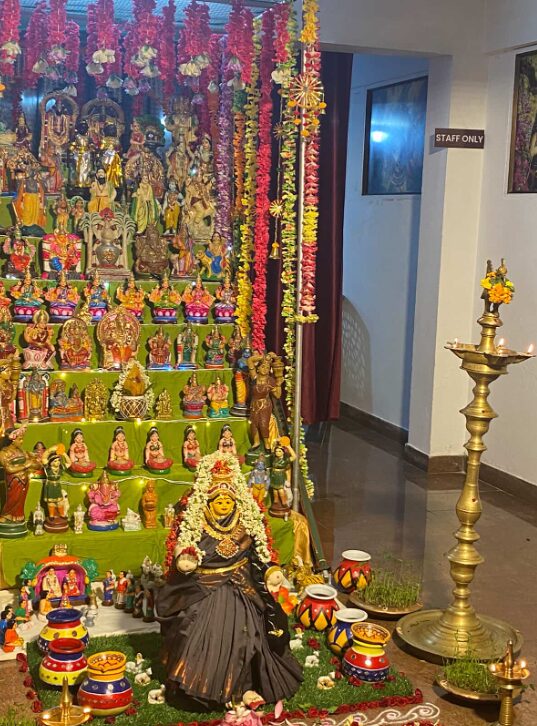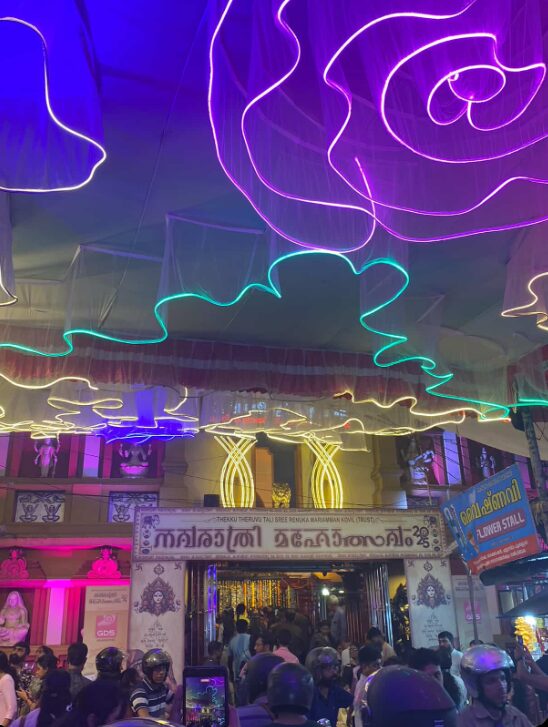The city of Kozhikode , with its rich blend of Malabar history and coastal culture, celebrates Navaratri with a unique fervour that beautifully bridges the traditions of Kerala and Tamil Nadu. A spiritual focal point for this nine-night festival is the venerable Maariyamma Temple (often referred to as Renukamariyamman Temple), an ancient shrine that vibrates with the intense energy of the Divine Mother. Maariyamma Temple in Kozhikode is a renowned spiritual site, especially vibrant during Navratri, when the atmosphere transforms with devotional energy and festive decorations. Each year, large crowds of devotees gather here to celebrate the nine nights dedicated to the Goddess, marked by special rituals, beautifully adorned temple premises, and lively cultural events that infuse the local community with joy and devotion.
The Sacred Abode: Understanding Goddess Maariyamma
The Maariyamma Temple is particularly significant as it is one of the important centers of Maariyamman worship in Kerala, which has strong roots in the Dravidian folk traditions.
The Deity: Maariyamman, the presiding deity, is a powerful form of Shakti (the Divine Feminine). She is revered as the goddess of Rain (Mari in Tamil means both ‘rain’ and ‘change’) and the protector from diseases. This dual nature nurturing and fierce makes her worship during Navaratri especially potent.
Cultural Anchor: Situated in the city’s heart, the temple serves as a cultural and spiritual home for many residents, particularly the Tamil-speaking community whose traditions have integrated seamlessly into Kozhikode’s cosmopolitan fabric.
The Atmosphere: The temple possesses a deeply sincere, powerful, and folk-religious atmosphere, distinct from the grand kerala-style temples, making it an evocative place to experience the festival’s raw spiritual energy.
The Nine Nights: A Fusion of Traditions
Navaratri, meaning ‘Nine Nights’, is dedicated to the worship of the nine forms of Goddess Durga. At the Maariyamma Temple, the celebrations unfold with rituals that reflect the best of South Indian traditions.
Days 1-9: The Triad of Power
The festival is traditionally divided into three sets of three days, each dedicated to a different aspect of the Goddess:
Days 1-3 (Durga/Kali): Dedicated to Durga (or Kali), the Goddess of Power and destruction of evil and impurities. Special pujas are performed to invoke her fierce energy, necessary to destroy ego and ignorance.
Days 4-6 (Lakshmi): Dedicated to Lakshmi, the Goddess of spiritual and material wealth. Rituals focus on prosperity, abundance, and the blessing of grace.
Days 7-9 (Saraswati): Dedicated to Saraswati, the Goddess of Wisdom, Arts, and Learning. These are the most significant days in Kerala and at the Maariyamma Temple, culminating in the worship of books and instruments.
The Visual Delight: Bommakkolu

One of the most striking visual elements of the celebration at or around the temple is the Bommakkolu (also called Golu or Kolu). This custom, prominent in Tamil and Karnataka Navaratri, involves the elaborate arrangement of dolls and figurines on tiered steps.
The Narrative: The Golu narrates stories from Hindu epics, depicts saints, and shows scenes of daily life, offering a unique blend of spirituality and social commentary.
Community Sharing: Families and temple devotees visit each other’s Golu displays, exchanging gifts, singing devotional songs, and sharing Sundal (a variety of sweet or savoury lentil and pulse preparations).
The Sacredness of Knowledge
The spiritual fervour peaks during the final three days, which hold immense cultural importance in Kerala and at the temple.
Durgashtami (Eighth Day): This is the day of Pooja Veppu (placing for worship). Devotees reverently place their books, educational materials, and professional tools (such as musical instruments, engineering implements, or artisan tools) before the Goddess Saraswati within the temple precincts or their homes.
Mahanavami (Ninth Day): The objects remain untouched under the direct protection and blessing of the Goddess. The entire atmosphere is one of profound silence and respect for the tools of knowledge and livelihood.
The Auspicious Vidyarambham
The festivities reach their sacred and emotional climax on the tenth day, Vijayadashami, which marks the triumph of good over evil (Goddess Durga over Mahishasura) and the most auspicious time to begin new ventures.
Vidyarambham: The Maariyamma Temple is a major centre for the Vidyarambham ceremony the ritualistic initiation of children into the world of learning.
The Ritual: Priests or scholars gently hold the index finger of a child (usually aged two or three) and guide them to trace the first letters often ‘Hari Sri Ganapataye Namaha’ on a platter of raw rice or sand. This symbolic act invokes the blessings of Saraswati for a life filled with knowledge.
Beyond Rituals: Cultural Vibrancy
Throughout Navaratri, the area surrounding the temple buzzes with cultural activity.
Musical Offerings: Devotional concerts (bhajans and kirtans) are common, featuring traditional Carnatic music known as Sangeetha Aradhana.
Traditional Arts: Local cultural organizations often host performances of classical dance forms like Bharatanatyam and Mohiniyattam, dedicated to the Goddess.
A visit to the Maariyamma Temple during Navaratri is not just a spiritual pilgrimage; it is an immersion into a unique cultural confluence, where the deep devotion of the Malabar region meets the vibrant traditions of the Tamil diaspora, all under the watchful, powerful gaze of the Mother Goddess.

